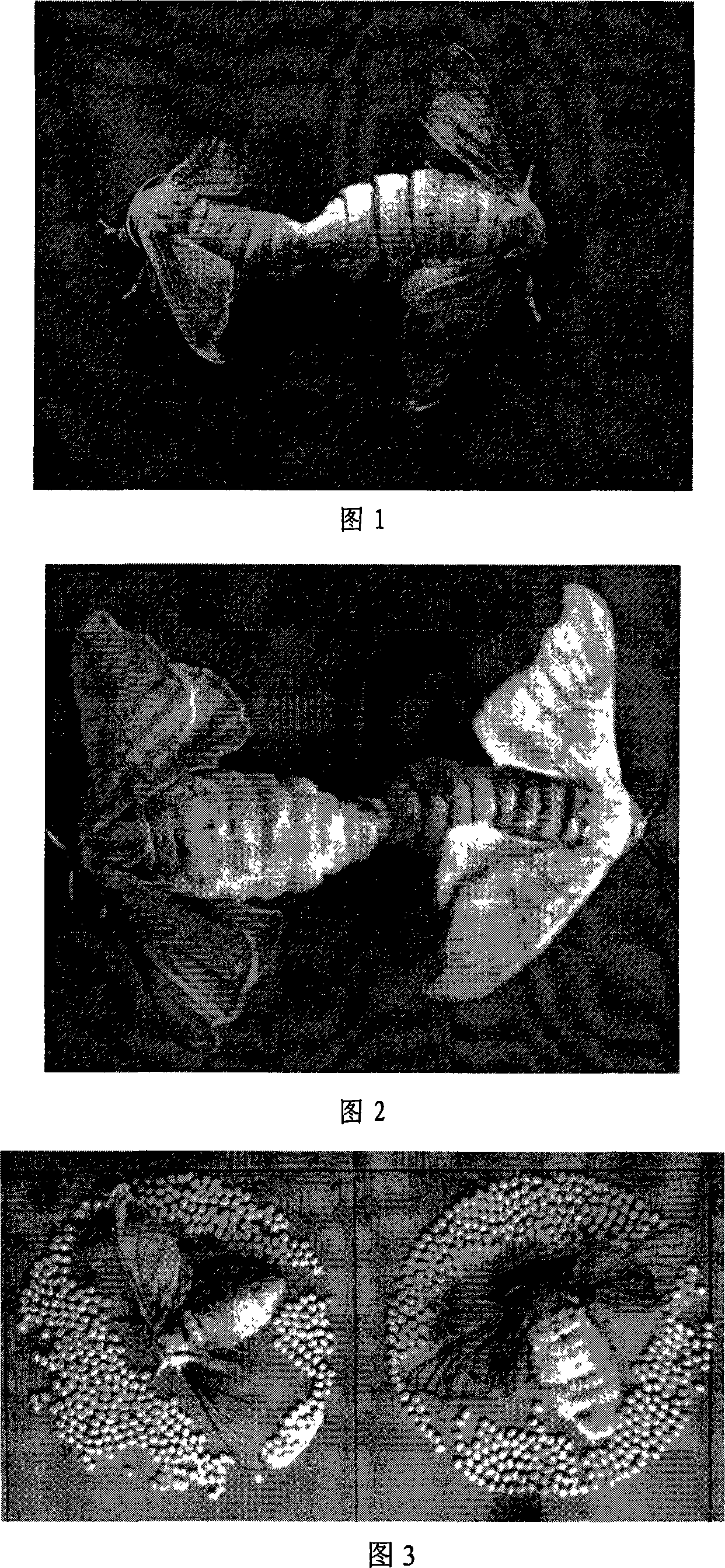Method for breeding varieties of silkworm without palea scales on wings of imago
A cultivating method and variety technology, applied in the field of cultivating adult wingless hairy silkworm varieties, can solve problems such as affecting the health of seed producers and surrounding people, difficulty in preventing and controlling microparticle diseases, and troubled silkworm seed production enterprises, etc. Hygienic, high-quality cocoon silk, good for control
- Summary
- Abstract
- Description
- Claims
- Application Information
AI Technical Summary
Problems solved by technology
Method used
Image
Examples
specific Embodiment approach
[0023] DETAILED DESCRIPTION OF THE PREFERRED EMBODIMENTS Through genetic analysis, the lack of scales in the silkworm is a recessive trait, and only in the homozygous state of the gene does the lack of scales appear.
[0024] 1. The scaleless mutant in Bombyx mori is associated with a lack of scale precursor cell differentiation followed by excessive apoptosis. Dev Genes Evol, 216, 2006(11): 721-726)
[0025] 1. Source: The silkworm species collected and preserved from the Institute of Sericulture, Chinese Academy of Agricultural Sciences, and provided externally.
[0026] 2. Main characteristics (according to "China Silkworm Variety Chronicle" Agricultural Press, May 1987, silkworm variety characteristics and characteristics term description traits, hereinafter the same.): Chinese dimorphic four-drown variety; larvae have limited markings, females The silkworms are common spot silkworms, and the male silkworms are plain silkworms. The silkworms are thick and strong, eat mulb...
Embodiment 1
[0028](1) Crossbreed the silkworm Scaleless P33 as the parent (female or male parent) and the production variety as the other parent (father or female parent) to obtain the first generation of hybrid F1; (2) use the production silkworm variety "Furong "(publicly known and public, see references: Feng Jiaxin editor-in-chief, Silkworm Breeding Anthology, Zhejiang University Press, September 2002: 544-548) carries out backcrossing and obtains BC1; P33 was used as the test cross parent, and the egg circle corresponding to the scurvy moth was selected for rearing, and then backcrossed with hibiscus to obtain BC2. By analogy, the steps of backcrossing and testcrossing were repeated, and after 4-6 generations of backcrossing of the silkworm variety "Furong", adult wings without scales were obtained, and other economic traits such as total cocoon quantity, cocoon layer ratio, cocoon silk length, The silk length, unwinding rate and cleanliness reach the level of the reincarnation paren...
Embodiment 2
[0044] (1) Using the silkworm Scaleless P33 as the parent (female or male parent) to cross with the production silkworm variety "7532" (father or female parent) to obtain the first generation of hybrid F1; (2) using the same production silkworm variety "7532" 7532” [commonly known and public, see reference: Feng Shulun. Breeding of Silkworm Summer and Autumn Variety 75 New × 7532, Jiangsu Sericulture, 1985 (3): 1-5] to obtain BC1 by backcrossing; (3) using moth area (egg Circle) half division method, use P33 as the test cross parent to carry out test cross, select the oviposites corresponding to Lepidoptera moths to breed, and then use "7532" backcross to obtain BC2. By analogy, repeat the steps of backcrossing and testcrossing. After 4-6 consecutive generations of backcrossing of the silkworm variety "7532" for production, the trait of no scales and hairs can be obtained, and other economic traits such as total cocoon quantity, cocoon layer rate, and cocoon silk length can be ...
PUM
 Login to View More
Login to View More Abstract
Description
Claims
Application Information
 Login to View More
Login to View More - R&D
- Intellectual Property
- Life Sciences
- Materials
- Tech Scout
- Unparalleled Data Quality
- Higher Quality Content
- 60% Fewer Hallucinations
Browse by: Latest US Patents, China's latest patents, Technical Efficacy Thesaurus, Application Domain, Technology Topic, Popular Technical Reports.
© 2025 PatSnap. All rights reserved.Legal|Privacy policy|Modern Slavery Act Transparency Statement|Sitemap|About US| Contact US: help@patsnap.com

